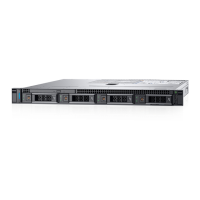Option Description
PCI ASPM L1 Link
Power
Management
Enables or disables the PCI ASPM L1 Link Power Management. This option is set to Enabled by default.
System Security
You can use the System Security screen to perform specic functions such as setting the system password, setup password and disabling
the power button.
Viewing System Security
To view the System Security screen, perform the following steps:
1 Power on, or restart your system.
2 Press F2 immediately after you see the following message:
F2 = System Setup
NOTE: If your operating system begins to load before you press F2, wait for the system to nish booting, and then
restart your system and try again.
3 On the System Setup Main Menu screen, click System BIOS.
4 On the System BIOS screen, click System Security.
System Security Settings details
The System Security Settings screen details are explained as follows:
Option
Description
CPU AES-NI Improves the speed of applications by performing encryption and decryption by using the Advanced Encryption
Standard Instruction Set (AES-NI). This option is set to Enabled by default.
System Password Sets the system password. This option is set to Enabled by default and is read-only if the password jumper is not
installed in the system.
Setup Password Sets the setup password. This option is read-only if the password jumper is not installed in the system.
Password Status Locks the system password. This option is set to Unlocked by default.
TPM Security
NOTE: The TPM menu is available only when the TPM module is installed.
Enables you to control the reporting mode of the TPM. The TPM Security option is set to O by default. You can
only modify the TPM Status TPM Activation, and the Intel SGX elds if the TPM Status eld is set to either On
with Pre-boot Measurements or On without Pre-boot Measurements.
When TPM 1.2 is installed, the TPM Security option is set to O, On with Pre-boot Measurements, or On
without Pre-boot Measurements.
TPM 1.2 security information
TPM Information Changes the operational state of the TPM. This option is set to No Change by default.
TPM Firmware Indicates the rmware version of the TPM.
TPM Status Species the TPM status.
TPM Command Controls the Trusted Platform Module (TPM). When set to None, no command is sent to
the TPM. When set to Activate, the TPM is enabled and activated. When set to
Pre-operating system management applications 37

